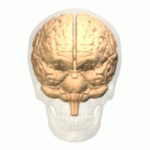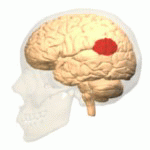User:Chiara Lawrence/sandbox
Relavent Links
[edit]Middlebury College on Wikipedia
Here is a link to the page I am editing Temporoparietal Junction
Here is a link to my contributions page
Here is a link to my partner's (Karma Lama) sandbox


The temporoparietal junction (TPJ) is an area of the brain where the temporal and parietal lobes meet, at the posterior end of the Sylvian fissure. The TPJ incorporates information from primarily the thalamus, the limbic system, as well as the visual, auditory and somaesthetic areas and is connected to the temporal and prefrontal cortex, which allows the TPJ to integrate information from the external environment and information from within the body. [1]This area is known to play a crucial role in self-other distinction processes and theory of mind (ToM),[2] and damage to this area has been implicated in producing out-of-body experiences (OBEs).[3] OBEs may also be induced by electrically stimulating the TPJ. Electromagnetic disruptions of the TPJ have been shown to affect individuals' abilities to make moral decisions.[4]
Involvement in Theory of Mind
[edit]Mentalizing requires the collaboration of functionally related regions of the brain to form the distinction between self and other mental states and to create a comprehensive understanding of those mental states so that we may recognize, understand, and predict behavior.[1] In general the mentalizing process is mediated by the dopaminergic-serotonergic system, which involves the TPJ as well as other associative regions necessary for mentalizing.[1] Recent studies suggest that both the left TPJ, working in conjunction with the frontal cortex, and the right TPJ are involved in the representation of mental states; furthermore they suggest that the TPJ is particularly active in making the distinction between the mental states of self and others. A study in Nature Neuroscience from 2004 describes how the TPJ is involved in processing socially relevant cues including gaze direction and goal-directed action and also explains that results from the study show that lesions to this area of the brain result in an impaired ability to detect another persons belief.[5] Moreover, studies have reported an increase in activity in the TPJ when patients are absorbing information through reading or images regarding other peoples' beliefs but not while observing information about physical control stimuli.[6] Some studies, however, have shown that the TPJ, along with the cingulate cortex, is more specifically involved with attributing beliefs, but the process of mentalizing more generally is associated more with the medial prefrontal cortex. [7] Another study in Current Biology from 2012 identifies the importance of the TPJ in both low-level, such as simple discrimination, and high-level, such as the ability to empathize, sociocognitive operations.[8] In July 2011, a review from Neuropsychologia presented a model of the mentalizing network that established that mental states are first detected in the TPJ.[1] The TPJ is comprised of two discrete anatomical regions, the inferior parietal lobule (IPL) and the caudal parts of the superior temporal sulcus (pSTS), and both are active in the process of distinction between mental states of different individuals; thus, it is probable that this detection is the outcome of the combination and coordination of these two parts.[1] Additionally, the right TPJ is involved in the ventral attention stream and contributes to the ability to focus attention on a particular stimuli or objective. It has also been observed that the interaction and communication between the dorsal and ventral streams involves the TPJ.[1]
Involvement in Disorders
[edit]As previously mentioned, the dopaminergic-seratonergic system mediates our ability to distinguish and understand others beliefs as well as predict their behavior in light of that understanding. In certain disorders, involving the dopaminergic-seratonergic system, this mentalizing process is disrupted and part or all of the process is impaired; this includes schizophrenia, autism, Parkinson's disease, and Alzheimer's disease.[1]
Alzheimer's Disease
[edit]Reduced metabolism in the TPJ, along with the superior frontal sulcus, correlates with Alzheimer’s patients’ inability to perceive themselves as others do (with a third-person point of view); the discrepancy between a patients’ understanding of their own cognitive impairment and the actual extent of their cognitive impairment increases as metabolism in the TPJ decreases.[9] Additionally, the TPJ contains the praxicon, a dictionary of representations of different human actions, which is necessary to distinguishing between actions of the self and other people. Because Alzheimer’s patients, as well as patients with other forms of dementia, with anosognosia are unable to distinguish between the normal actions of other people and their own diminished abilities, it is expected that there must be damage to the TPJ that is arresting this cognitive function.[9]
Schizophrenia
[edit]The decreased ability for schizophrenia patients to function in social situations has been related to a deficit within the mentalizing process.[10] There have been relatively few studies that have examined the role of mentalizing in schizophrenia patients; the findings of these studies as they relate to the activation of the TPJ are varied. Some studies have found decreased activation of the TPJ in schizophrenia patients who were asked to make inferences about other peoples' social intentions based on cartoons; other studies, however, performed similar assessments of schizophrenia patients and found that the TPJ actually became hyperactive, compared to control individuals without schizophrenia, in the TPJ.[7] This indicates that there is abnormal activation of the TPJ in these patients while performing tasks that involving understanding social intention of others, but the directionality of this abnormal activity is not clear, or possibly not universal throughout schizophrenia patients. A study from Schizophrenia Research in 2010 found that the changes in activation in the TPJ were lateralized; they found that there was reduced activity in only the right TPJ and proposed that based on previous research about the different roles of the right and left TPJ the findings indicated that there was a more general deficit in the overall mentalizing process for these patients, but their ability to understand other individuals' basic social intentions through observing interaction is not impaired.[10]
Another study from 2010 in Biological Psychiatry found that there was a connection between the auditory hallucinations in schizophrenia and the TPJ; the TPJ has been determined as a critical node in the auditory-verbal hallucination system.[11] This study found that there was a significant decrease in the connectivity between the left TPJ and the right hemispheric homotope of the Broca's area, which is related to the production of language that is also characteristic of AVH events.[11] This aspect of impairment seen in schizophrenia patients may also be related to the involvement of the TPJ with producing out of body experiences.
Future for Possible Treatments
[edit]Vasopressin is a neuropeptide that is involved in regulating social behaviors, including social memory and recognition.[12] A study from 2011 in Translational Psychiatry examined the connection between vassopressin and cortical areas that are involved in processing social interactions including the TPJ. This study looked specifically at the brain regions that we active in men who were given vasopressin and tested based on familiarity related tasks.[12] They found that the introduction of vasopressin caused a localized specific change in social recognition-related activity in the left TPJ/Brodmann area 39; the presence of vasopressin diminishes the heightened activity in the left TPJ that is present upon exposure to an unfamiliar social stimulus indicating that the presence of vasopressin leads individuals to associate an unfamiliar face with a familiar category more readily. While recognizing that this is the first study that has looked into this connection, the authors propose that it has potential to lead into further research about regulating the TPJ with vasopressin or a similar compound, which could allow pharmacologists to target this area of the brain and help with certain disorders including autism, social anxiety disorder.[12] Perhaps such an approach could also be used to treat certain symptoms of schizophrenia or other disorders with know social cognitive impairments.
Involvement in Out of Body Experiences
[edit]Focus for my partner, Karma Lama
References
[edit]- ^ a b c d e f g Abu-Akel, A.; Shamay-Tsoory, S. (2011 Sep). "Neuroanatomical and neurochemical bases of theory of mind". Neuropsychologia. 49 (11): 2976. doi:10.1016/j.neuropsychologia.2011.07.012. PMID 21803062. S2CID 36226051.
{{cite journal}}: Check date values in:|date=(help)CS1 maint: date and year (link) - ^ Rebecca Saxe, Nancy Kanwisher (2003). "People thinking about thinking people: The role of the temporo-parietal junction in "theory of mind"". NeuroImage. 19 (4): 1835–1842. doi:10.1016/S1053-8119(03)00230-1. PMID 12948738. S2CID 206118958.
- ^ Olaf Blanke and Shahar Arzy (2005). "The Out-of-Body Experience: Disturbed Self-Processing at the Temporo-Parietal Juncti". The Neuroscientist. 11 (1): 16–24. doi:10.1177/1073858404270885. PMID 15632275. S2CID 8172076.
- ^ "Morality is modified in the lab". BBC News. 2010-03-30.
- ^ Samson, D (2004 May). "Left temporoparietal junction is necessary for representing someone else's belief". Nature Neuroscience. 7 (5): 499–500. doi:10.1038/nn1223. PMID 15077111. S2CID 9818818.
{{cite journal}}: Check date values in:|date=(help); Unknown parameter|coauthors=ignored (|author=suggested) (help)CS1 maint: date and year (link) - ^ Saxe, R (2003 Aug). "People thinking about thinking people. The role of the temporo-parietal junction in "theory of mind"". NeuroImage. 19 (4): 1835–42. doi:10.1016/s1053-8119(03)00230-1. PMID 12948738. S2CID 206118958.
{{cite journal}}: Check date values in:|date=(help); Unknown parameter|coauthors=ignored (|author=suggested) (help)CS1 maint: date and year (link) - ^ a b Lee, J.; Quintana, J.; Nori, P.; Green, M. F. (2011). "Theory of mind in schizophrenia: exploring neural mechanisms of belief attribution". Social Neuroscience. 6 (5–6): 569–81. doi:10.1080/17470919.2011.620774. PMC 3928144. PMID 22050432.
{{cite journal}}: CS1 maint: date and year (link) - ^ Santiesteban, I.; Banissy, M. J.; Catmur, C.; Bird, G. (2012 Dec 4). "Enhancing social ability by stimulating right temporoparietal junction". Current Biology : CB. 22 (23): 2274–7. doi:10.1016/j.cub.2012.10.018. PMID 23122848. S2CID 5636515.
{{cite journal}}: Check date values in:|date=(help)CS1 maint: date and year (link) - ^ a b Salmon, E.; Ruby, P.; Perani, D.; Kalbe, E.; Laureys, S.; Adam, S.; Collette, F. (2005). Two aspects of impaired consciousness in Alzheimer's disease. Progress in Brain Research. Vol. 150. pp. 287–98. doi:10.1016/S0079-6123(05)50021-9. ISBN 9780444518514. PMID 16186031.
{{cite book}}: CS1 maint: date and year (link) - ^ a b Das, P.; Lagopoulos, J.; Coulston, C. M.; Henderson, A. F.; Malhi, G. S. (2012 Feb). "Mentalizing impairment in schizophrenia: a functional MRI study". Schizophrenia Research. 134 (2–3): 158–64. doi:10.1016/j.schres.2011.08.019. PMID 21943555. S2CID 9222011.
{{cite journal}}: Check date values in:|date=(help)CS1 maint: date and year (link) - ^ a b Vercammen, A (2010 May 15). "Auditory hallucinations in schizophrenia are associated with reduced functional connectivity of the temporo-parietal area". Biological Psychiatry. 67 (10): 912–8. doi:10.1016/j.biopsych.2009.11.017. PMID 20060103. S2CID 8473758.
{{cite journal}}: Check date values in:|date=and|year=/|date=mismatch (help); Unknown parameter|coauthors=ignored (|author=suggested) (help) - ^ a b c Zink, CF (2011 Apr 4). "Vasopressin modulates social recognition-related activity in the left temporoparietal junction in humans". Translational Psychiatry. 1 (4): e3. doi:10.1038/tp.2011.2. PMC 3309468. PMID 22832391.
{{cite journal}}: Check date values in:|date=(help); Unknown parameter|coauthors=ignored (|author=suggested) (help)CS1 maint: date and year (link)
